Brain Garden exhibition shows roots of creativity
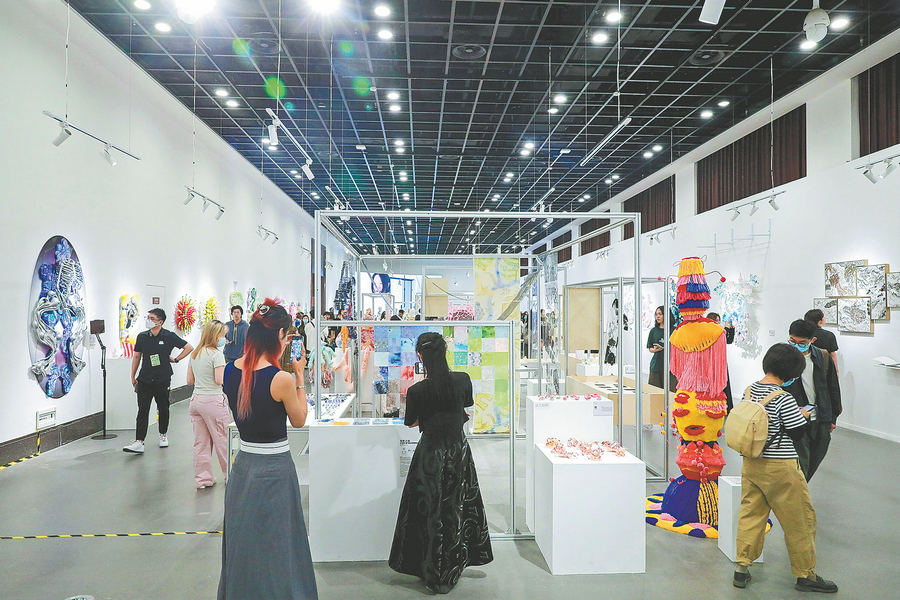
An exhibition held in Hangzhou, Zhejiang province, presents a captivating showcase of more than 3,000 works created by 2,500 fresh graduates from the China Academy of Art. CHINA DAILY
Youth and the future are key themes in celebration of talent, Li Yingxue reports.
The garden represents a treasured concept of human innocence, a realm where dreams thrive. Whether it is the Garden of Eden, Arcadia, Utopia, or Marco Polo's "Xanadu" under Kublai Khan, it is a place where flowers flourish in abundance, prosperity reigns, conflicts are nonexistent, and suffering is unknown.
Under the theme of Brain Garden, the fifth Zhijiang International Youth Art Festival 2023 and the China Academy of Art graduation season concluded on June 18 in Hangzhou, East China's Zhejiang province. It offered a wide variety of online and offline artistic shows and activities centered on the future and youth, and attracted an audience of more than 400,000.
With an exhibition area spanning nearly 70,000 square meters at six venues, including the Zhejiang Exhibition Hall, the Zhejiang Art Museum and the World Tourism Museum, this citywide event presented a captivating showcase of over 3,000 works created by 2,500 graduates holding bachelor's, master's, and doctorate degrees.
"The theme of Brain Garden is a summons, calling forth the dialectics of freedom and the spirit of creativity," says Gao Shiming, head of the China Academy of Art. "The responsibility of art is to create, to generate fresh mind-body experiences for ordinary life, and to construct a rich future vision for human history."
Gao finds this year's graduation projects have one feature, which is engaging in dialogue — with the classics, with the everyday, with oneself and with the future.
"I'm not concerned about artificial intelligence replacing human creativity because anything that can be replaced is not genuine creativity. Human artistic creation is guided by purpose and propelled by desire, making it a matter of the soul," Gao says.
"Just as photography in the 19th century did not replace painting, computers and AI cannot replace artists and designers," he says.
He thinks the festival has helped to fully unlock the power of art and innovation, inspiring young people with art and facilitating efforts to make the city of Hangzhou, which blends tradition and modernity, a destination and spiritual home for young artists worldwide and a world cradle of cultural innovation in the post-pandemic era.
"Our objective is to transform Hangzhou into a 'boundary-less academy', igniting its youthfulness, liveliness, and sense of fashion," Gao says.
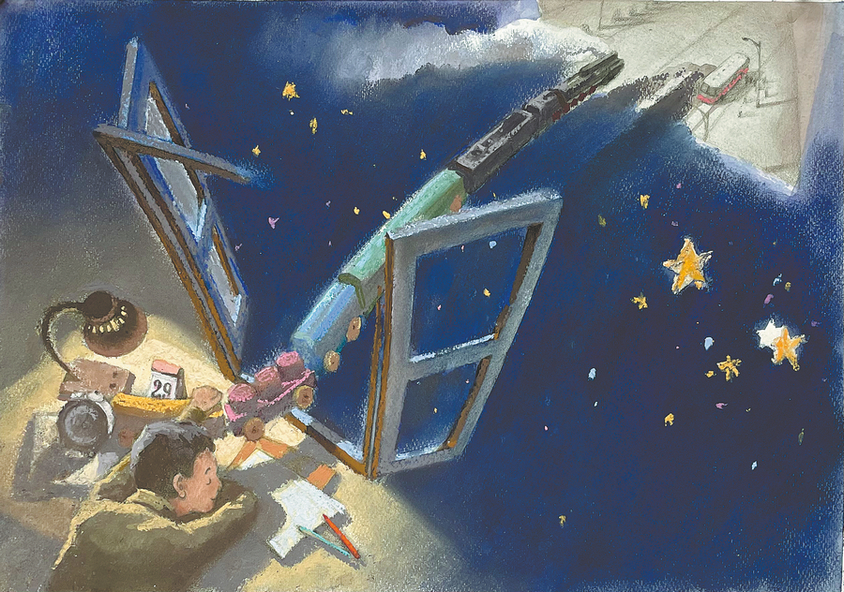
One of the graduates' work, by Ren Shuhuai, from the School of Animation and Games. CHINA DAILY
Exploring the unknown
The opening ceremony of the event was held at Wulin Square in Hangzhou on June 1, during which audiences enjoyed a fashion show with hyper-audiovisual scenes at the Metaverse Art Academy.
Over 80 works from 46 students in fashion and apparel design at the School of Design were showcased in the fashion show. The designers created their works with an open mindset and from multiple dimensions, placing emphasis on frontier exploration results in art, philosophy, and science and technology, while paying attention to topics such as survival crises, cultural alienation, social care, body language and emotional barriers.
Under the subtheme of Infinite Thoughts, the School of Chinese Painting and Calligraphy exhibits 303 works of 204 graduates at the World Tourism Museum.
At the same venue, the School of Sculpture and Public Art channels its reflections on the transformation and evolution of the individual and society and its desire for exploring the unknown through another subtheme, Nomadic Seeds.
One highlight is Zheng Shuxian's graduation project, a series of sculpture artworks named Yuanqi (the start of fate). Based on the theme of the Legend of the White Snake, the 23-year-old created three sculptures and three relief artworks which received positive feedback from the audience during the exhibition.
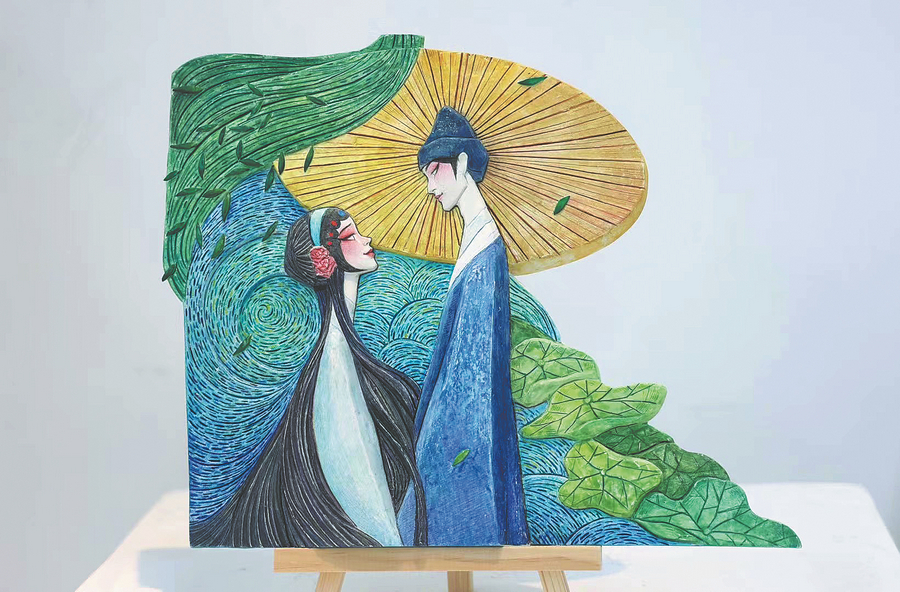
A relief artwork for the graduation project by Zheng Shuxian are based on stories of the Legend of the White Snake. CHINA DAILY
It's her first exhibit and she was happy to see that the audience could tell that the sculptures were characters from the legend at first sight.
"Sculpture is a valuable exercise for art students as it allows us to approach an object from multiple dimensions, offering a more rational and diverse perspective," she says.
Qian Yunke, Zheng's tutor, thinks Zheng's works are characterized by a refined and aesthetic approach. "Unlike other artists who employ deconstruction and exaggeration, her works feature vivid forms, concise sculptural language and subtle color palettes. The theatrical masks are primarily depicted on the facial expressions, while the costumes maintain an elegant simplicity," Qian says.
Qian thinks choosing the theme of traditional Chinese opera in sculptural creations undoubtedly presents its challenges, but at the same time, "creating sculptures with a focus on Chinese opera is not only a creative transformation but also an innovative development of China's outstanding traditional culture".
Qian thinks that one of Zheng's greatest strengths in her learning process is her ability to incorporate her painting skills into three-dimensional sculptural forms. "This can be attributed to her early development in the fields of comics and illustrations, which have greatly influenced her artistic approach," he adds.
Zheng was attracted to drawing as a child. She chose sculpture as she wants to accept more challenges after years of painting.
During her five years of study, she focused on using different materials to make sculptures. For her graduation work, she used paper pulp which was initially challenging.
Zheng accepted an offer to work for a video game company as a key animator and she is looking forward to the new job. "In the future, I aspire to work on innovative projects, such as creating original games or telling compelling stories," she says.
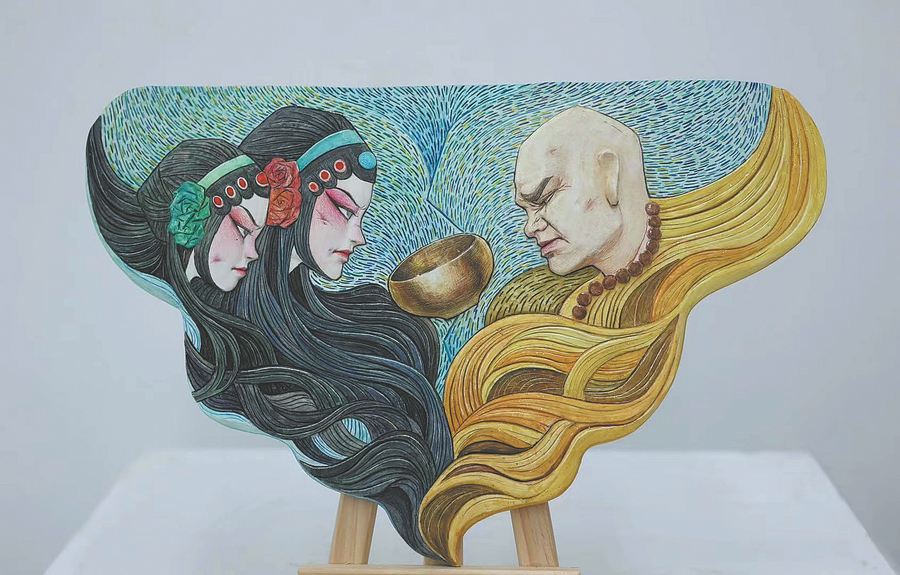
A relief artwork for the graduation project by Zheng Shuxian are based on stories of the Legend of the White Snake. CHINA DAILY
The School of Intermedia Art exhibits more than 200 works of 73 undergraduates and 34 postgraduates. With a subtheme of World Giants, the graduation exhibition claims to present profound changes in people's relationship with the world and inspires young creators to expand their minds and meditate on their souls and the outer world.
Halina Troshyna, 34, from Belarus, is a doctoral graduate in the School of Intermedia Art, specializing in visual culture and curatorial studies.
After graduating from high school, she went to St. Petersburg in Russia, one of the centers of world art history, to study Western art history and Chinese.
In 2018, Troshyna was admitted to the China Academy of Art, where she continued her doctoral studies.
"The academy provided me with abundant artistic nourishment, allowing me to explore various forms of interdisciplinary art creation while studying both Eastern and Western art history. It immersed me in a whole new realm of artistic practice," she says.
Through the international platform provided by the school, she joined the curatorial team at the China Design Museum of the China Academy of Art.
Over the course of three years, she actively participated in curating the renowned exhibition, From Vkhutemas to Visions of the Future: A History of Soviet Design, from scratch. She became the bridge of both the Chinese and Russian sides during the preparation.
The exhibition, held at the museum from March 17 last year to Sept 22 of the same year, showcased the rich legacy of Soviet design.
"Participating in this exhibition provided me with the invaluable opportunity to network and collaborate with world-class design artists. Additionally, I had the privilege to engage in a series of enriching academic activities, further enhancing my personal growth and development," she says.
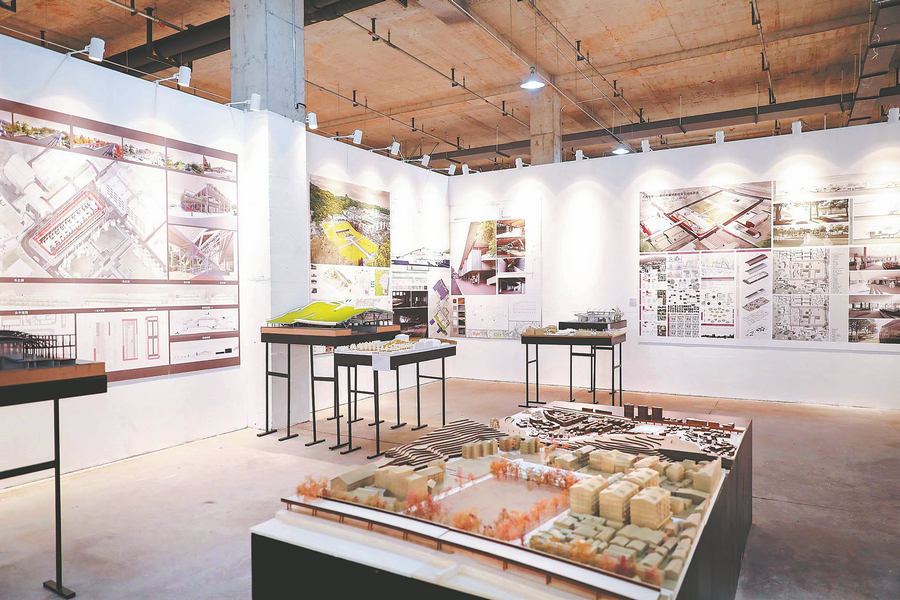
A corner of the exhibition that spans six venues in Hangzhou. CHINA DAILY
First step
The China Academy of Art started to hold a graduation season open to all Hangzhou residents in 2010 and rebranded it as the Zhijiang International Youth Art Festival in 2019.
Gao explains that the most important reason to host off-campus exhibitions is to expose students' works to society, allowing them to be reviewed by the public in formal exhibition venues, and engage in professional presentations and peer interactions.
"The graduation exhibition is the final step in talent development at the school and serves as the first step for students to enter society and embark on their professional careers," he says.
He Chenghao, 23, a graduate of this year at the School of Design and Innovation, is going to study for the Master in Design Studies, focusing on mediums domain, at Harvard University this fall.
For his graduation work, He and his classmates Zhan Shuoyu and Ma Songtao created a programmable protein intelligence system called Bio-Turing, collaborating with a research group led by principal investigator Chen Zibo, an assistant professor from Westlake University.
By designing programmable and modular proteins capable of interacting with each other, they achieved the collaboration of multiple proteins to perform complex functions. "It can be understood as a protein-driven biological computer," He explains.
He says, in contrast to purely artistic disciplines, he places great importance on external feedback and the stimulating thoughts it generates, and additionally, he possesses a keen interest in emerging technologies and groundbreaking concepts.
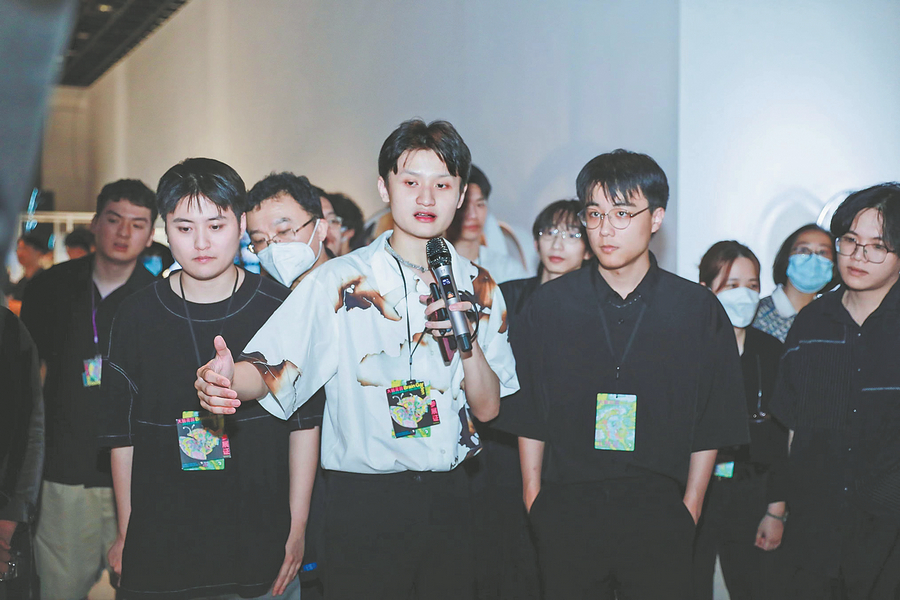
He Chenghao (center), a graduate, introduces his artwork to visitors. CHINA DAILY
He's undergraduate studies focused on utilizing emerging technologies, including new media, for design and artistic creations. He has taken courses in curatorial practice, interactive design, data visualization, and algorithmic art, among others, which have prepared him well for his future studies at Harvard.
"Going to study at Harvard serves two purposes. On one hand, it is an opportunity for learning and academic growth. On the other hand, it allows us to showcase our current portfolio of work and explore potential opportunities for business collaborations, to some extent," says He, who is also the co-founder of Continuous Tracks Studio.
"I hope that what lies ahead for me will continue to be filled with uncertainty," He says.
According to Cheng Bin, He's tutor, their department has innovated in the teaching structure, adopting a project-based approach and dividing it into different research institutes.
Students have the flexibility to switch institutes at the end of each semester.
Cheng says the new teaching structure will be implemented in all schools at the China Academy of Art, and in the future he is hoping to collaborate with other universities on interdisciplinary teaching.
"Students like He will participate in numerous projects throughout their four years of study, and the content they create can be showcased in competitions and exhibitions. Following our current teaching philosophy, we aim to break down the walls of traditional schooling and promote an education without boundaries," Cheng says.
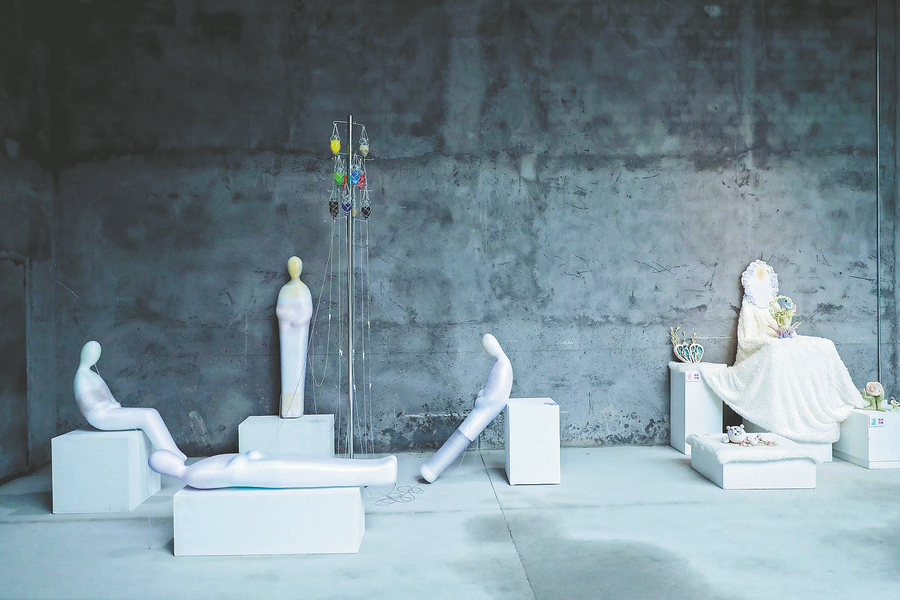
Some of the works on display, by graduates from the School of Sculpture and Public Art. CHINA DAILY
Related articles
-
 Folk culture and operas the inspiration of an ink figure painter
Folk culture and operas the inspiration of an ink figure painterMore
-
 Building legacies
Building legaciesMore
-
 Stories and scenes of the world bloom under a writer's painting brushes
Stories and scenes of the world bloom under a writer's painting brushesMore
-
 Decoding contemporary China through ancient art
Decoding contemporary China through ancient artMore
-
 Studies of master Qi Baishi to intensified, calls academy's annual conference
Studies of master Qi Baishi to intensified, calls academy's annual conferenceMore
-
 Funeral Banner of Lady Dai
Funeral Banner of Lady DaiMore
